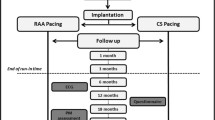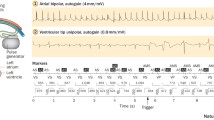Abstract
Several observational studies have indicated that selection of pacing mode may be important for the clinical outcome in patients with symptomatic bradycardia, affecting the development of atrial fibrillation (AF), thromboembolism, congestive heart failure, mortality and quality of life. In this paper we present and discuss the most recent data from six randomized trials on mode selection in patients with sick sinus syndrome (SSS). In pacing mode selection, VVI(R) pacing is the least attractive solution, increasing the incidence of AF and—as compared with AAI(R) pacing, also the incidence of heart failure, thromboembolism and death. VVI(R) pacing should not be used as the primary pacing mode in patients with SSS, who haven't chronic AF. AAIR pacing is superior to DDDR pacing, reducing AF and preserving left ventricular function. Single site right ventricular pacing—VVI(R) or DDD(R) mode—causes an abnormal ventricular activation and contraction (called ventricular desynchronization), which results in a reduced left ventricular function. Despite the risk of AV block, we consider AAIR pacing to be the optimal pacing mode for isolated SSS today and an algorithm to select patients for AAIR pacing is suggested. Trials on new pacemaker algorithms minimizing right ventricular pacing as well as trials testing alternative pacing sites and multisite pacing to reduce ventricular desynchronization can be expected within the next years.
Similar content being viewed by others
References
Andersen HR, Thuesen L, Bagger JP, Vesterlund T, Thomsen PE. Prospective randomised trial of atrial versus ventricular pacing in sick-sinus syndrome. Lancet 1994;344:1523–1528.
Andersen HR, Nielsen JC, Thomsen PE, Thuesen L, Mortensen PT, Vesterlund T, Pedersen AK. Long-term follow-up of patients from a randomised trial of atrial versus ventricular pacing for sick sinus syndrome. Lancet 1997;350:1210–1216.
Nielsen JC, Andersen HR, Thomsen PE, Thuesen L, Mortensen PT, Vesterlund T, Pedersen AK. Heart failure and echocardiographic changes during long-term followup of patients with sick sinus syndrome randomized to single chamber atrial or ventricular pacing. Circulation 1998;97:987–995.
Lamas GA, Orav J, Stambler BS, Ellenbogen KA, Sgarbossa EB, Huang SKS, Marinchak RA, Estes NAM3, Mitchell GF, Lieberman EH, Mangione CM, Goldman L, For the Pacemaker Selection in the Elderly Investigators. Quality of life and clinical outcomes in elderly patients treated with ventricular pacing as compared with dualchamber pacing. N Engl J Med 1998;338:1097–1104.
Ellenbogen KA, Stambler BS, Orav EJ, Sgarbossa EB, Tullo NG, Love CA, Wood MA, Goldman L, Lamas GA. Clinical characteristics of patients intolerant to VVIR pacing. Am J Cardiol 2000;86(1):59–63.
Mattioli AV, Vivoli D, MattioliG. Influence of pacing modalities on the incidence of atrial fibrillation in patients without prior atrial fibrillation. A prospective study. Eur Heart J 1998;19:282–286.
Mattioli AV, Castellani ET, Vivoli D, Sgura FA, Mattioli G. Prevalence of atrial fibrillation and stroke in paced patients without prior atrial fibrillation: A prospective study. Clin Cardiol 1998;21:117–122.
Connolly SJ, Kerr CR, Gent M, Roberts RS, Yusuf S, Gillis AM, Sami MH, Talajic M, Tang AS, Klein GJ, Lau C, Newman DM. Effects of physiologic pacing versus ventricular pacing on the risk of stroke and death due to cardiovascular causes. Canadian Trial of Physiologic Pacing Investigators. N Engl J Med 2000;342:1385–1391.
Kerr CR. Effect of pacing mode on cardiovascular death and stroke. The canadian trial of physiologic pacing: Long term follow-up. Pacing. Clin Electrophysiol 2002;25 (Part II):553 (Abstract).
Lamas GA, Lee KL, Sweeney M, Silverman R. Ventricular pacing or dual-chamber pacing for sinus-node dysfunction. N Engl J Med 2002;346:1854–1862.
Sweeney MO, Hellkamp AS, Ellenbogen KA, Greenspon AJ, Freedman RA, Lee KL, Lamas GA. Adverse effect of ventricular pacing on heart failure and atrial fibrillation among patients with normal baseline QRS duration in a clinical trial of pacemaker therapy for sinus node dysfunction. Circulation 2003;107:2932–2937.
Nielsen JC, Kristensen L, Andersen HR, Mortensen PT, Pedersen OL, Pedersen AK. A randomized comparison of atrial and dual-chamber pacing in 177 consecutive patients with sick sinus syndrome: Echocardiographic and clinical outcome. J AmColl Cardiol 2003;42:614–623.
Wilkoff BL, Cook JR, Epstein AE, Greene HL, Hallstrom AP, Hsia H, Kutalek SP, Sharma A. Dual-chamber pacing or ventricular backup pacing in patients with an implantable defibrillator: The Dual Chamber and VVI Implantable Defibrillator (DAVID) Trial. JAMA 2002;288:3115–3123.
Moss AJ, Zareba W, Hall WJ, Klein H, Wilber DJ, Cannom DS, Daubert JP, Higgins SL, Brown MW, Andrews ML. Prophylactic implantation of a defibrillator in patients with myocardial infarction and reduced ejection fraction, N Engl J Med 2002;346:877–883.
Kristensen L, Nielsen JC, Pedersen AK, Mortensen PT, Andersen HR. AV block and changes in pacing mode during long-term of 399 consecutive patients with sick sinus syndrome treated with an AAI/AAIR pacemaker. Pacing Clin Electrophysiol 2001;24:358–365.
Andersen HR, Nielsen JC, Thomsen PE, Thuesen L, Vesterlund T, Pedersen AK, Mortensen PT. Atrioventricular conduction during long-term follow-up of patients with sick sinus syndrome. Circulation 1998;98:1315–1321.
Andersen HR, Nielsen JC. Pacing in sick sinus syndrome-Need for a prospective, randomized trial comparing atrial with dual chamber pacing. Pacing Clin Electrophysiol 1998;21:1175–1179.
Charles RG, McComb JM. Systematic trial of pacing to prevent atrial fibrillation (STOP-AF). Heart 1997;78:224–225.
Author information
Authors and Affiliations
Rights and permissions
About this article
Cite this article
Albertsen, A., Nielsen, J. Selecting the Appropriate Pacing Mode for Patients with Sick Sinus Syndrome: Evidence from Randomized Clinical Trials. Card Electrophysiol Rev 7, 406–410 (2003). https://doi.org/10.1023/B:CEPR.0000023156.58418.2a
Issue Date:
DOI: https://doi.org/10.1023/B:CEPR.0000023156.58418.2a




